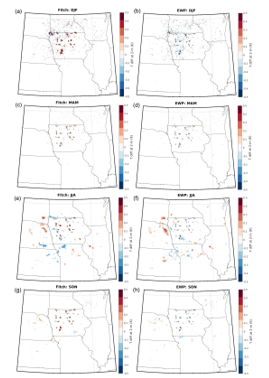Climate Effects From Wind Turbines
High-resolution simulations are conducted with the Weather Research and Forecasting (WRF) model in order to quantify downstream effects on near-surface climate and the differences in climate effects that arise from two different parameterizations in WRF (Fitch and the newly developed EWP scheme). We compare the impact on local climate from wind turbine arrays using two different parameterizations from a year-long simulation.
Both wind farm parameterization schemes show climate impact from the operation of wind turbines in Iowa, but these are of a modest magnitude and generally confined to summer months. Consistent with the weaker wakes in the EWP parameterization, the downstream effects on near-surface climate properties are also smaller than those from the more commonly applied Fitch scheme. This may imply that past studies have overestimated the local climate impact from wind turbine operation. Further, consistent with previous research using only the Fitch scheme (Pryor et al. 2018a), even for the relatively high WT installed capacity densities in Iowa, have little impact beyond the grid cells in which WT are deployed and the lack spatial coherence that would imply substantial impact on regional climate.
It is currently not possible to make recommendations with regard to which wind farm parameterization exhibits higher fidelity or to draw inferences with regard to whether the relative performance may vary with prevailing climate conditions and/or wind turbine deployment configuration. However, the sensitivities documented herein to the wind farm parameterization are of sufficient magnitude to potentially influence wind turbine array siting decisions. Thus, our research findings imply high value in undertaking combined long-term high-fidelity observational studies in support of model validation and verification.
No energy source has zero impact on the environment. Wind turbines impact the local environment due to generation of downstream wakes (areas of disturbed flow behind each wind turbine). Like the water wake behind a motorboat, wind turbines create a wake of slower, more choppy air that eventually spreads and recovers its momentum. The wake increases mixing in the lower atmosphere and thus wind turbines have an impact on near-surface air temperature and humidity. However, this research shows these effects are modest and that they may be overestimated by the most commonly applied numerical model.

